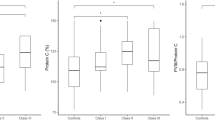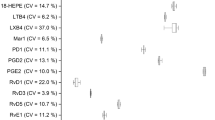Abstract
Obese patients have been described at increased risk of thrombotic thrombocytopenic purpura, a disease caused by anti-ADAMTS13 autoantibodies. ADAMTS13 has a structure homology with the adipokine thrombospondin-1. We previously demonstrated an increased presence of anti-ADAMTS13 antibodies in obese patients. We aimed to study the changes induced by weight loss after bariatric surgery on some inflammatory and coagulative parameters and their link with anti-ADAMTS13 autoantibodies. We studied 100 obese patients before and after weight loss induced by bariatric surgery and 79 lean volunteers as controls. We measured anthropometric, metabolic and inflammatory parameters, thrombospondin-1, ADAMTS13 activity, anti-ADAMTS13 autoantibodies, Von Willebrand factor. At baseline, 13 % of patients was positive for anti-ADAMTS13 autoantibodies, while all controls were negative. Thrombospondin-1 levels were higher in obese subjects with than without antibodies, with a positive correlation between the two parameters. In multiple logistic regression analysis only thrombospondin-1 levels predicted positivity for anti-ADAMTS13 antibodies. After weight loss both anti-ADAMTS13 antibodies and thrombospondin-1 reduced significantly. Weight loss in obesity improves the inflammatory and coagulative profile, and in particular anti-ADAMTS13 autoantibodies, ADAMTS13 activity and thrombospondin-1.



Similar content being viewed by others
References
K.K. Nicol, B.J. Shelton, M.A. Knovich, J. Owen, Overweight individuals are at increased risk for thrombotic thrombocytopenic purpura. Am. J. Hematol. 74, 170–174 (2003)
S.K. Vesely, J.N. George, B. Lämmle, J. Studt, L. Alberio, M. El-Harake et al., ADAMTS13 activity in thrombotic thrombocytopenic purpura–hemolytic uremic syndrome: relation to presenting features and clinical outcomes in a prospective cohort of 142 patients. Blood 102, 60–68 (2003)
H.H. Tuncer, R.A. Oster, S.T. Huang, M.B. Marques, Predictors of response and relapse in a cohort of adults with thrombotic thrombocytopenic purpura-hemolytic uremic syndrome: a single-institution experience. Transfusion 47, 107–114 (2007)
C.C. Deford, J.A. Reese, L.H. Schwartz, J.J. Perdue, J.A. Kremer Hovinga, B. Lämmle et al., Multiple major morbidities and increased mortality during long-term follow-up after recovery from thrombotic thrombocytopenic purpura. Blood 122, 2023–2029 (2013)
X.L. Zheng, Structure-function and regulation of ADAMTS-13 protease. J. Thromb. Haemost. 11(Suppl 1), 11–23 (2013)
S.P. Weisberg, D. McCann, M. Desai, M. Rosenbaum, R.L. Leibel, A.W. Ferrante Jr, Obesity is associated with macrophage accumulation in adipose tissue. J. Clin. Invest. 112, 1796–1808 (2003)
H. Wu, S. Ghosh, X.D. Perrard, L. Feng, G.E. Garcia, J.L. Perrard et al., T-cell accumulation and regulated on activation, normal T cell expressed and secreted up-regulation in adipose tissue in obesity. Circulation 115, 029–1038 (2007)
H. Xu, G.T. Barnes, Q. Yang, G. Tan, D. Yang, C.J. Chou et al., Chronic inflammation in fat plays a crucial role in the development of obesity-related insulin resistance. J. Clin. Invest. 112, 1821–1830 (2003)
S. Cinti, G. Mitchell, G. Barbatelli, I. Murano, E. Ceresi, E. Faloia et al., Adipocyte death defines macrophage localization and function in adipose tissue of obese mice and humans. J. Lipid. Res. 46, 2347–2355 (2005)
J. Martinez, K. Verbist, R. Wang, D.R. Green, The relationship between metabolism and the autophagy machinery during the innate immune response. Cell Metab. 17, 895–900 (2013)
C. Haiming, Adipocytokines in obesity and metabolic disease. J. Endocrinol. 220(2), T47–59 (2014)
V. Varma, A. Yao-Borengasser, A.M. Bodles, N. Rasouli, B. Phanavanh, G.T. Nolen et al., Thrombospondin-1 is an adipokine associated with obesity, adipose inflammation, and insulin resistance. Diabetes 57, 432–439 (2008)
P. Kong, C. Gonzalez-Quesada, N. Li, M. Cavalera, D.W. Lee, N.G. Frangogiannis, Thrombospondin-1 regulates adiposity and metabolic dysfunction in diet-induced obesity enhancing adipose inflammation and stimulating adipocyte proliferation. Am. J. Physiol. Endocrinol. Metab. 305, E439–450 (2013)
A.M. Lombardi, R. Fabris, A. Scarda, V. Zanato, C. Dal Prà, P. Scarparo et al., Presence of anti-ADAMTS13 antibodies in obesity. Eur. J. Clin. Invest. 42(11), 1197–1204 (2012)
K. Kokame, Y. Nobe, Y. Kokubo, A. Okayama, T. Miyata, FRETSVWF73, a first fluorogenic substrate for ADAMTS13 assay. Br. J. Haematol. 129, 93–100 (1995)
I. Simera, D. Moher, J. Hoey, K.F. Schulz, D.G. Altman, A catalogue of reporting guidelines for health research. Eur. J. Clin. Invest. 40, 35–53 (2010)
C.C. Deford, J.A. Reese, L.H. Schwartz, J.J. Perdue, J.A. Kremer Hovinga, B. Lämmle et al., Multiple major morbidities and increased mortality during long-term follow-up after recovery from thrombotic thrombocytopenic purpura. Blood 122, 2023–2029 (2013)
P.E. Morange, M.C. Alessi, Thrombosis in central obesity and metabolic syndrome: mechanisms and epidemiology. Thromb. Haemost. 110, 669–680 (2013)
M. Versini, P.Y. Jeandel, E. Rosenthal, Y. Shoenfeld, Obesity in autoimmune diseases: not a passive bystander. Autoimmun. Rev. 13, 981–1000 (2014)
A. Bernardo, C. Ball, L. Nolasco, J.F. Moake, J. Dong, Effects of inflammatory cytokines on the release and cleavage of the endothelial cell-derived ultralarge von Willebrand factor multimers under flow. Blood 104(1), 100–106 (2004)
S. Taniguchi, T. Hashiguchi, T. Ono, K. Takenouchi, K. Nakayama, T. Kawano et al., Association between reduced ADAMTS13 and diabetic nephropathy. Thromb. Res. 125(6), e310–316 (2010)
M.K. Freynhofer, S.C. Gruber, V. Bruno, T. Höchtl, S. Farhan, V. Zaller et al., Prognostic value of plasma von Willebrand factor and its cleaving protease ADAMTS13 in patients with atrial fibrillation. Int. J. Cardiol. 168(1), 317–325 (2013)
G.C. Hugenholtz, J. Adelmeijer, J.C. Meijers, R.J. Porte, R.T. Stravitz, T. Lisman, An unbalance between von Willebrand factor and ADAMTS13 in acute liver failure: implications for haemostasis and clinical outcome. Hepatology 58(2), 752–761 (2013)
M. Rieger, P.M. Mannucci, J.A. Kremer Hovinga, A. Herzog, G. Gerstenbauer, C. Konetschny et al., ADAMTS13 autoantibodies in patients with thrombotic microangiopathies and other immunomediated diseases. Blood 106(4), 1262–1267 (2005)
R. Grillberger, V.C. Casina, P.L. Turecek, X.L. Zheng, H. Rottensteiner, F. Scheiflinger, Anti-ADAMTS13 IgG autoantibodies present in healthy individuals share linear epitopes with those in patients with thrombotic thrombocytopenic purpura. Haematologica 99(4), e58–60 (2014)
F. Peyvandi, S. Lavoretano, R. Palla, H.B. Feys, K. Vanhoorelbeke, T. Battaglioli et al., ADAMTS13 and anti-ADAMTS13 antibodies as markers for recurrence of acquired thrombotic thrombocytopenic purpura during remission. Haematologica 93, 232–239 (2008)
X.L. Zheng, H.M. Wu, D. Shang, E. Falls, C.G. Skipwith, S.R. Cataland et al., Multiple domains of ADAMTS13 are targeted by autoantibodies against ADAMTS13 in patients with acquired idiopathic thrombotic thrombocytopenic purpura. Haematologica 95(9), 1555–1562 (2010)
F. Scheiflinger, P. Knöbl, B. Trattner, B. Plaimauer, G. Mohr, M. Dockal et al., Non-neutralizing IgM and IgG antibodies to von willebrand factor–cleaving protease (ADAMTS-13) in a patient with thrombotic thrombocytopenic purpura. Blood 102, 3241–3243 (2010)
P. Knöbl, Unravelling the immunologic response in thrombotic thrombocytopenic purpura. J. Thromb. Haemost. 4, 2352–2354 (2006)
L. Dong, V. Chandrasekaran, W. Zhou, H.M. Tsai, Evolution of ADAMTS13 antibodies in a fatal case of thrombotic thrombocytopenic purpura. Am. J. Hematol. 83, 815–817 (2008)
R. Froehlich-Zahnd, J.N. George, S.K. Vesely, D.R. Terrell, K. Aboulfatova, J.F. Dong et al., Evidence for a role of anti-ADAMTS13 autoantibodies despite normal ADAMTS13 activity in recurrent thrombotic thrombocytopenic purpura. Haematologica 97(2), 297–303 (2012)
W. Pos, B.M. Luken, N. Sorvillo, J.A.K. Hovinga, J. Voorberg, Humoral immune response to ADAMTS13 in acquired thrombotic thrombocytopenic purpura: auto-antibodies to ADAMTS13. J. Thromb. Haemost. 9(7), 1285–1291 (2011)
Acknowledgments
This work was supported by funding from MIUR PRIN—Programmi di Ricerca Scientifica di Rilevante Interesse Nazionale, anno 2010–2011—prot. 2010329EKE_005 given to Roberto Vettor.
Funding
This work was supported by funding from MIUR PRIN—Programmi di Ricerca Scientifica di Rilevante Interesse Nazionale, anno 2010–2011—prot. 2010329EKE_005 given to Roberto Vettor.
Contributions
AM L, RF and VZ wrote the manuscript. VZ also contributed to literature search and generation of figures. LB contributed to data analysis and interpretation. C DP, MF, LP, G BDM, contributed to data collection. FF and RV revised the manuscript. All authors had final approval of the submitted and published versions.
Author information
Authors and Affiliations
Corresponding author
Ethics declarations
Informed consent
informed consent was obtained from all individual participants included in the study.
Conflict of interest
The authors declare that they have no competing interests.
Ethical approval
All procedures performed in studies involving human participants were in accordance with the ethical standards of the institutional and/or national research committee and with the 1964 Helsinki declaration and its later amendments or comparable ethical standards.
Electronic supplementary material
Rights and permissions
About this article
Cite this article
Zanato, V., Lombardi, A.M., Busetto, L. et al. Weight loss reduces anti-ADAMTS13 autoantibodies and improves inflammatory and coagulative parameters in obese patients. Endocrine 56, 521–527 (2017). https://doi.org/10.1007/s12020-016-1059-6
Received:
Accepted:
Published:
Issue Date:
DOI: https://doi.org/10.1007/s12020-016-1059-6




